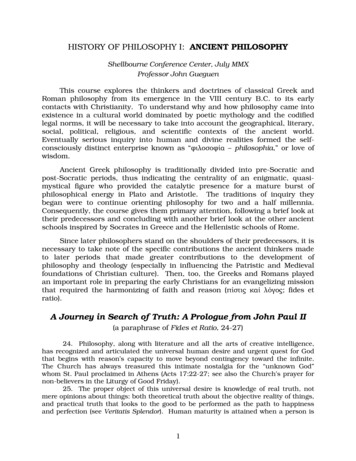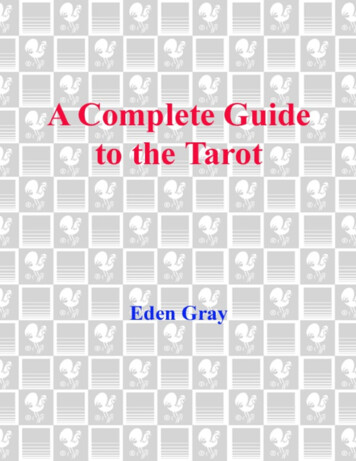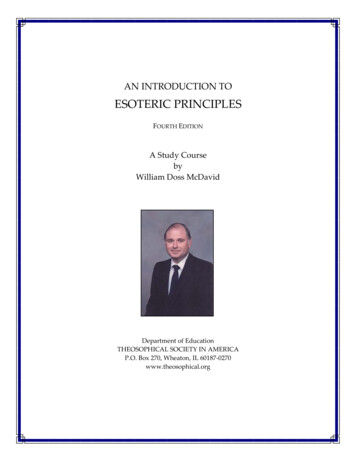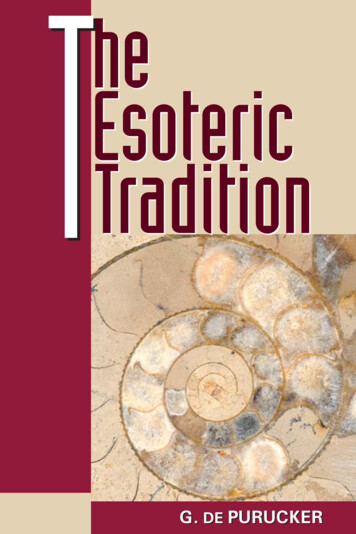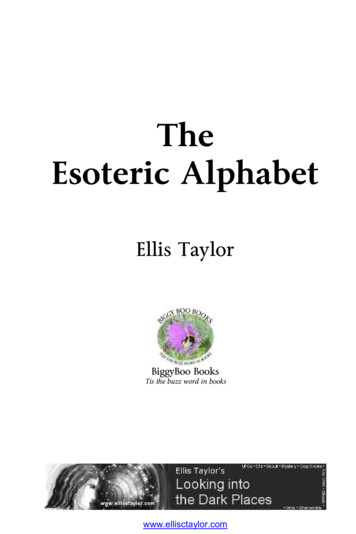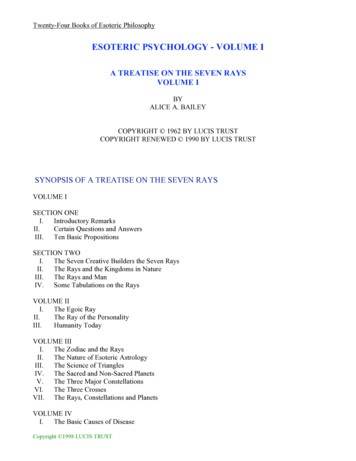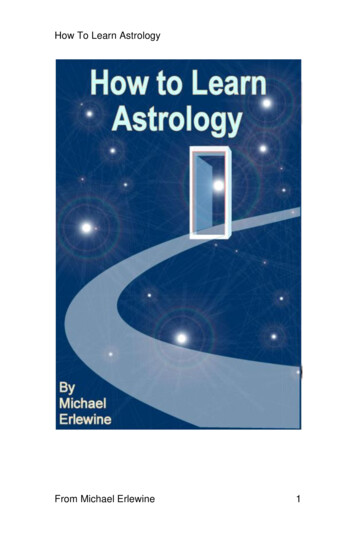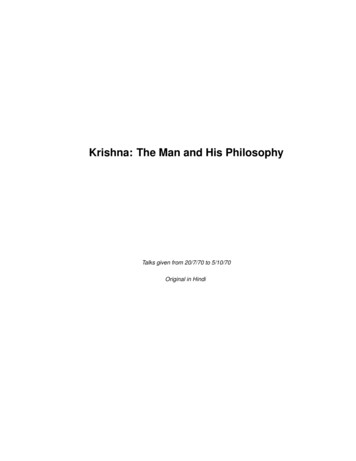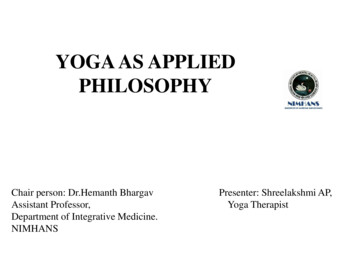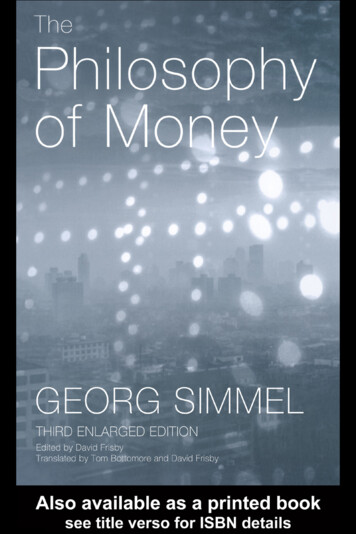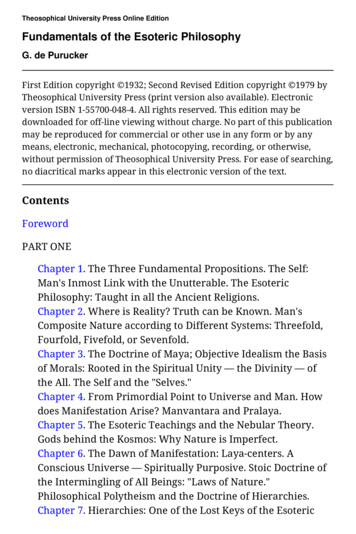
Transcription
Theosophical University Press Online EditionFundamentals of the Esoteric PhilosophyG. de PuruckerFirst Edition copyright 1932; Second Revised Edition copyright 1979 byTheosophical University Press (print version also available). Electronicversion ISBN 1-55700-048-4. All rights reserved. This edition may bedownloaded for off-line viewing without charge. No part of this publicationmay be reproduced for commercial or other use in any form or by anymeans, electronic, mechanical, photocopying, recording, or otherwise,without permission of Theosophical University Press. For ease of searching,no diacritical marks appear in this electronic version of the text.ContentsForewordPART ONEChapter 1. The Three Fundamental Propositions. The Self:Man's Inmost Link with the Unutterable. The EsotericPhilosophy: Taught in all the Ancient Religions.Chapter 2. Where is Reality? Truth can be Known. Man'sComposite Nature according to Different Systems: Threefold,Fourfold, Fivefold, or Sevenfold.Chapter 3. The Doctrine of Maya; Objective Idealism the Basisof Morals: Rooted in the Spiritual Unity — the Divinity — ofthe All. The Self and the "Selves."Chapter 4. From Primordial Point to Universe and Man. Howdoes Manifestation Arise? Manvantara and Pralaya.Chapter 5. The Esoteric Teachings and the Nebular Theory.Gods behind the Kosmos: Why Nature is Imperfect.Chapter 6. The Dawn of Manifestation: Laya-centers. AConscious Universe — Spiritually Purposive. Stoic Doctrine ofthe Intermingling of All Beings: "Laws of Nature."Philosophical Polytheism and the Doctrine of Hierarchies.Chapter 7. Hierarchies: One of the Lost Keys of the Esoteric
Philosophy. The Pythagorean Sacred Tetraktys. The Ladder ofLife: The Legend of Padmapani.Chapter 8. Traces of the Esoteric Philosophy in Genesis.Chapter 9. Outline of Esoteric Cosmogony. Globes, Rounds andRaces: Cosmic Time Periods.Chapter 10. The Doctrine of Swabhava — Self-becoming —Characteristic Individuality. Man, Self-evolved, his ownCreator. Monadologie of Leibniz contrasted with Teachings ofthe Esoteric Philosophy.Chapter 11. The Cosmic Pilgrimage. From Unself-consciousGod-spark to Fully Self-conscious God.Chapter 12. Psychology: According to the Esoteric Philosophy.Immortality is Conditional: the Loss of the Soul.Chapter 13. The Process of Evolution. Self, Ego, and Soul: "IAm" and "I am I."Chapter 14. "Heavens" and "Hells": Teachings of the EsotericPhilosophy and of the Exoteric Religions.Chapter 15. The Evolution of the "Absolute." Generalized Planof Evolution on all Planes. Seven Keys to Wisdom and FutureInitiations.Chapter 16. Atma-vidya: How the One Becomes the Many."Lost Souls" and "Soulless Beings." Man, a Composite Being: NoAbiding Principle in Man.Chapter 17. The Silent Watcher.Chapter 18. The Spiritual-Psychological Hierarchy of Adepts.The Wondrous Being, the Buddhas, Nirmanakayas, Dhyanchohans.Chapter 19. The Seven Jewels and the Seven Stages ofInitiation.Chapter 20. The Higher Aspect of Human Psychology.Initiation and the Mysteries: Avataras, Buddhas, andBodhisattvas. Their Relation to Globes, Rounds, and Races.Chapter 21. Initiations and the Ancient Mysteries. Root-racesand Their Subdivisions. Globe Rounds. Planetary Rounds.Solar Kalpas: How Calculated. Racial Cataclysms.
Chapter 22. The Hierarchy of Compassion. The Incarnation ofthe Manasaputras.Chapter 23. The Sun and the Planets. Their Role in theEvolutionary Drama.PART TWOChapter 24. The Ten Stages of Being according to the SyrianSystem. Esoteric Method of Teaching: Paradoxes, Intuition.Chapter 25. The Mysteries of Septenary Nature.Correspondences: Globes, Elements, Human Principles. TheSeven Sacred Planets of the Ancients. Racial Time Periods andCatastrophes.Chapter 26. The Microcosm, a Mirror of the Macrocosm.Elements, Principles, Manifestations of the One Life. Relativity:a Fundamental Conception of the Ancient Wisdom.Chapter 27. The Two Fundamental Kosmical Hierarchies:Matter and Spirit-Consciousness. Chaos-Theos-Kosmos: GodsMonads-Atoms.Chapter 28. The Adventure of an Atom. Laya-centers: Sun,Comets, and Planets; Soul and Monad. The Keynote ofOccultism.Chapter 29. Space: the Boundless All. Infilled withInterlocking, Interpenetrating Universes. One Action, OneHierarchical Intelligence, One Course of Operation throughoutNature: One Organism, One Universal Life.Chapter 30. The Interrelation of Gods, Monads, Atoms — a Keyto the Doctrine of Evolution. Successive Emanations: Sheaths.Higher Beings Emanating and Clothing Themselves in Hosts ofLower Beings. Morality Based on the Structure of the Universe.Chapter 31. The Building of the Kosmos. The SameFundamental Law throughout Life and Being: an EndlessLadder of Progress. Analogical Processes of Kosmical andPsychological Development. The River of Life.Chapter 32. Out of the Invisible into the Visible. From theVisible into the Invisible. The Magnum Opus.
Chapter 33. The Life-wave and the Seven Elements. TheEsoteric Philosophy as Taught by the Stoics.Chapter 34. The Spaces of Space. The Secret Doctrine, aUnifier: Universal Keys. Doctrines of the Void and of theFullness Contrasted.Chapter 35. Occultism and the Mystery Schools. Seven Degreesof Initiation: Man Becomes a God. Seven Kosmic Planes: ourPlanetary Chain of Seven Globes on the Four Lower Planes —the Passage of the Life-wave therethrough.Chapter 36. Interpenetrating Spheres of Being. Lokas andTalas: Bipolar Kosmical Principles and Elements. The "Heresyof Separateness."Chapter 37. The Framework of the Kosmos. Lokas and Talas:Principles and Elements, Worlds — Not States Merely. Spacethe Ultimate Reality.Chapter 38. Degeneration and Closing of the Schools of theMysteries. Neopythagorean and Neoplatonic Systems: MainSources of Christian Theology. Esoteric and ExotericTeachings: Symbolism.Chapter 39. Theosophy and Occultism. Occultism: theQuintessence of Truth, Reality; a Complete Whole. Occultismand Moral Responsibility. Our Solar System: a Kosmic Atom,Egg of Brahma.Chapter 40. Definitions of Deity: Atheism; Pantheism. Is there aSupreme Personal God? Kosmic Architects and Builders.Really to Know, One Must Become.Chapter 41. The Doctrine of the Spheres. The Universal SolarSystem and Our Solar System. The Seven Sacred Planets: Why"Sacred"?Chapter 42. The Doctrine of the Spheres in its Four Aspects.The Seven Sacred Planets and their Rectors: their Relation toour Earth-chain. The Circulations of the Kosmos: Outer Roundsand Inner Rounds; Sishtas. One Universal Basic Law: AsAbove, So Below. The Eye and the Heart Doctrines.Chapter 43. Analogy: the Life of Man and the Life of a
Planetary Chain. Occultism and Ethics: "Live the Life if ThouWouldst Know the Doctrine.Chapter 44. Principles of Thought and Study: can Occultism beTaught? Ancient Astrology a True Science. Our Earth-chain ofGlobes, the Seven Sacred Planets, and the Twelve ZodiacalSigns. Life-Atoms: the Building Blocks of the Universe.Chapter 45. Physiology, Psychology, and Pneumatology of theUniverse. Ten and Twelve Planes of the Universal SolarSystem: Intermediate Critical Planes. All Manifested Being aGraded Continuum of Interrelated, Interlocked Hierarchies:Each with its own Beginning and End. Sishtas and the Surplusof Life.Chapter 46. The Chela Life. Seven and Ten Life-waves: theCourse of the Monads around the Seven Globes; Laws ofAcceleration on the Downward and of Retardation on theUpward Arc. Fifth and Sixth Rounders. The Sacred Word.Chapter 47. Teacher and Pupil. Requisites of Chelaship.Chapter 48. The Heart of the Universe. The Way to Peace, Bliss,Understanding, is Within. The Great Quest — Know Thyself —the Whole Secret of Initiation. Our Responsibility: EthicalValues and the Laws of the Universe; Harmony.ForewordIn 1924 Katherine Tingley inaugurated within the esoteric body ofthe Theosophical Society a series of studies in The Secret Doctrineby H. P. Blavatsky, with Gottfried de Purucker as lecturer. In spiteof the fact that he had not studied under Mme. Blavatsky, as hadseveral among those present, she knew of none better preparedthan he to interpret this work "from the esoteric standpoint."Moreover, she felt assured that after she was gone he would bethere to "carry on these lessons," which ultimately would bepublished "for later generations."At the first meeting on January 4th, Katherine Tingley set the tone
of the gatherings by appealing to all present to cast asideeverything of a personal and limiting nature and "get more inharmony with our higher self — with that part that is eternal andthat is trying to open the way for us." Those attending shouldenter, "as did the neophytes of ancient days, in the spirit of selfforgetfulness," remembering that these studies were not beingheld primarily to enlarge the intellectual understanding of thestudent, but rather as an "earnest spiritual effort" to open theheart to the higher consciousness and stimulate the intuition forservice in the daily life. After the lectures Katherine Tingley spokefor a few minutes and usually called upon different ones for theircomments, herself giving the closing remarks. The members thenleft as they had come, in silence, which to her had marvelouspotency for inner growth.It was in this atmosphere of reverence for truth and for thelightbringers of mankind that G. de Purucker elucidated thespiritual principles upon which the "secret doctrine" of the agesrests. Fundamentals of the Esoteric Philosophy represents thestenographic record of those lectures given from 1924 to 1927,with periodic interruptions during Katherine Tingley's absenceon lecture tours in the United States or Europe. In 1931 thetranscripts were turned over to A. Trevor Barker for editing priorto publication in London, the quotations heading the chaptershaving been selected by Joseph H. Fussell, friend and colleague ofthe author.What makes this book significant among the many expositions ofThe Secret Doctrine that have appeared since 1888? Not least,perhaps, is the inspired treatment of the vast evolutionaryprocess that encompasses the rhythmic rebirth of worlds, ofhumans, and of every living being, for the purpose of bringinginto actuality the fullness of godhood infolded within every godspark. Propelled by ancient habit we too, in our cyclic descent
into earthly life, follow the same cosmic routes traveled by allmonads until, the lessons of planetary experience mastered, wegraduate as self-evolved divinities. How the One becomes themany, how spirit irradiates every particle of matter, is the oldstory — now retold with a wondrous clarity so that the readerdiscovers he has at hand those key-teachings that will enable himto test for himself whether or not any religious or philosophicconcept, ancient or modern, is in harmony with "that primevalspiritual and natural revelation" accorded the first thinkinghumans on earth. Throughout, like a golden sheen on the farhorizon of time, he perceives the oneness of humanity's spiritualinheritance and our commonality of divine origin and goal.Further, there is wide scholarship here: not only are the termsfrom the Sanskrit, Hebrew, and other ancient literaturesexplained etymologically, but they are given richer interpretationin the light of Dr. de Purucker's knowledge of our early racialhistory and of the traditional lore and sacred scriptures of Orientand Occident.For many, however, the greatest gift of all is his restorative trustin the dignity and nobility of man. We are indeed knights errantof eternity, bent on the ancient quest for a wisdom we knowexists but which seems ever to elude our grasp. In beingreminded of that quest, there is generated a devotion to truth andto the compassionate line of teachers — a devotion that haspower to move the soul, to lead us life after life toward thoseencounters that will purify and strengthen the character and fitus better to serve humanity's cause.The revision of this second edition has been undertaken withexceeding care and, while the few passages that pertained strictlyto the esoteric nature of the sessions have been deleted as havesome of the repetitions that are inevitable when a series ofaddresses is published almost verbatim, the lecture material has
been left practically intact.To have condensed and systematized the presentation wouldhave foiled the intent of the author. Intangibly, yet step by step,he builds atmosphere as he touches on this teaching or that,carries the thought for a distance and then turns to anotherteaching, seemingly different, yet relevant to the larger picture heis unfolding. In a later chapter or two he may return to the earlierthemes, develop them for a time, then again move on to otherdoctrines. Dr. de Purucker remarks more than once that in this heis deliberately following the ancient esoteric method of impartingsacred truths: repetition of the salient thought, but always withsufficient variation and enlargement of vision to draw the studenton so that the mind will not set itself in molds. The mind thatremains fluid is more responsive to intuition and the flow of lightthat may spontaneously illumine the soul when the inner natureis attuned.It is of interest that the original edition of Fundamentals of theEsoteric Philosophy published in 1932 did not include the first twolectures, but began with the third one. Their omission no doubtwas inadvertent; but, providentially, a few years after theauthor's death Kirby Van Mater, archivist for the Society, turnedup the two missing lectures among papers which presumably hadbeen returned with other material to headquarters from theEuropean centers to which Katherine Tingley had sent them in1924, to be shared with "appreciative minds." The pertinentportions of these meetings are now incorporated as sections i andii of chapter 1, preceding section iii which originally appeared asthe first chapter of the 1932 edition. The present volume isenhanced by their inclusion, for they amplify and deepen Dr. dePurucker's interpretation of the three fundamental propositionswith which H.
27.04.1979 · in the light of Dr. de Purucker's knowledge of our early racial history and of the traditional lore and sacred scriptures of Orient and Occident. For many, however, the greatest gift of all is his restorative trust in the dignity and nobility of man. We are indeed knights errant. of eternity, bent on the ancient quest for a wisdom we know. exists but which seems ever to elude our grasp. In .
